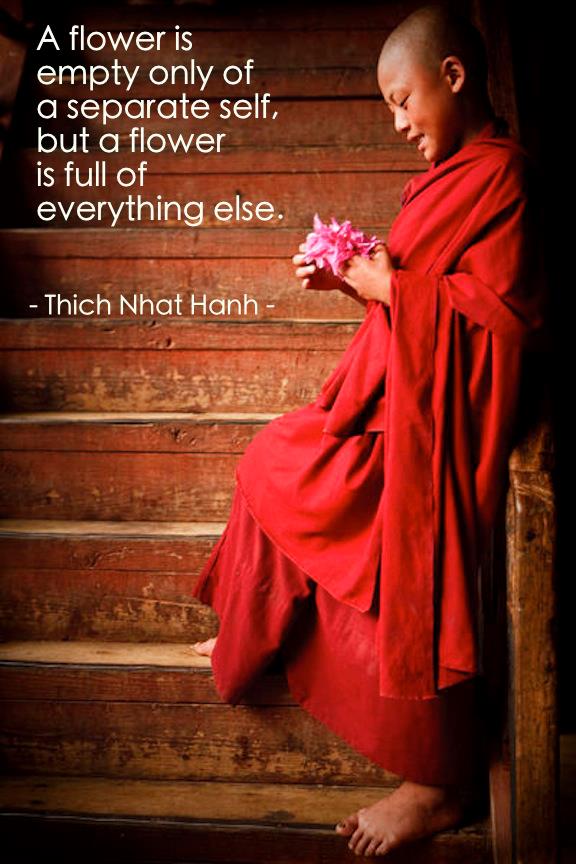What is non-self, Anatta (Pali)? It means impermanence. If things are impermanent, they don’t remain the same things forever. You of this moment are no longer you of a minute ago. There is no permanent entity within us, there is only a stream of being.This is a very profound teaching of the Buddha. For instance, looking into a flower, you can see that the flower is made of many elements that we can call non-flower elements.
When you touch the flower, you touch the cloud. You cannot remove the cloud from the flower, because if you could remove the cloud from the flower, the flower would collapse right away.
You don’t have to be a poet in order to see a cloud floating in the flower, but you know very well that without the clouds there would be no rain and no water for the flower to grow.
So cloud is part of flower, and if you send the element cloud back to the sky, there will be no flower. Cloud is a non-flower element. And the sunshine… you can touch the sunshine here.
If you send back the element sunshine, the flower will vanish. And sunshine is another non-flower element. And earth, and gardener… if you continue, you will see a multitude of non-flower elements in the flower.
In fact, a flower is made only with non-flower elements. It does not have a separate self. A flower cannot be by herself alone. A flower has to “inter-be” with everything else that is called non-flower.
That is what we call inter-being. You cannot be, you can only inter-be. The word inter-be can reveal more of the reality than the word “to be”. You cannot be by yourself alone, you have to inter-be with everything else.
So the true nature of the flower is the nature of inter-being, the nature of no self. The flower is there, beautiful, fragrant, yes, but the flower is empty of a separate self.
To be empty is not a negative note. Nagarjuna, of the second century, said that because of emptiness, everything becomes possible.
So a flower is described as empty. But I like to say it differently. A flower is empty only of a separate self, but a flower is full of everything else.
The whole cosmos can be seen, can be identified, can be touched, in one flower. So to say that the flower is empty of a separate self also means that the flower is full of the cosmos.
It’s the same thing. So you are of the same nature as a flower: you are empty of a separate self, but you are full of the cosmos. You are as wonderful as the cosmos, you are a manifestation of the cosmos.
So non-self is another guide that Buddha offers us in order for us to successfully practice looking deeply.
What does it mean to look deeply? Looking deeply means to look in such a way that the true nature of impermanence and non-self can reveal themselves to you.
Looking into yourself, looking into the flower, you can touch the nature of impermanence and the nature of non-self, and if you can touch the nature of impermanence and non-self deeply, you can also touch the nature of nirvana, which is the Buddha’s Third Dharma Seal.
~Thich Nhat Hanh~
Dharma Talk given on July 28, 1998
in Plum Village, France



